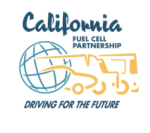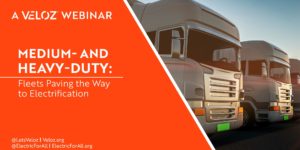On the road to a zero-carbon economy, medium and heavy-duty trucks (MDV/HDV) have been in the slow lane. Until now. Once considered futuristic, in the next year, over a hundred zero emission commercial freight vehicles will be available from 46 manufacturers.
And it is not a minute too soon. California has been turbocharging the zero-emissions vehicle (ZEV) truck industry by providing incentives for early adopters as well as ambitious targets for manufacturers. But despite California’s Advanced Clean Truck Rule, which requires that 40-75% (depending on platform) of all new trucks be zero emission in 2035, the California Air Resources Board (CARB) estimates that MDV/HDV will still be emitting a lot of carbon emissions. On the order of 31 MMt CO2e — in 2045.
Heavy Duty trucks making long haul trips and clocking the most miles pollute the most (contributing the highest share of GHG and NOx), stay on the road the longest (up to 20 years), and present the most formidable technology challenge. But they only constitute 10 percent of all trucks. So, is solving the heavy-duty-long haul truck challenge the key to accelerating our ride to a zero-emissions transportation sector?
HDV long haulers travel an average of 500 miles per trip. That means, range is king! HDV trucks weigh more than 26,000 pounds — moving them down the road takes power. That’s why range comes down to energy versus weight, and the race is on between hydrogen fuel cells and batteries to become competitive with diesel trucks. To go farther distances between charges, batteries must increase energy density while decreasing weight — not a simple feat — while fuel cell truck makers must solve for hydrogen storage on board. To date, fuel cells seem to have the HDV long- haul advantage because they have longer range for the weight. When it comes to shorter haul HDV, which emit the next highest amount of pollution and medium duty trucks, the race is neck and neck between Battery Electric Trucks (BET) and and Fuel Cell Electric Trucks (FCET) for precisely the same reason – energy versus weight and the range they deliver.
But both BET and FCET must solve for infrastructure with very different challenges. My last blog Charging Our Way Forward explored some of the universal build out challenges. For BET, reducing charging time requires new charging and battery technology. For FCET, reducing fill rate to diesel equivalent requires advances in storage: materials, geometry and energy density; and dispensing mechanisms: H2 compressors, pumps, hoses, nozzles, chillers. Both are on track to solve these issues by the end of the decade.
That’s not fast enough. Nor will it be cheap enough. These trucks stay on the road up to two decades. CARB estimates 94,000 HDV will need to retire early. To achieve the kind of market penetration we need, in a timeframe to meet California’s net zero 2045 goal, the total cost of ZEV HDV ownership should not only meet but beat diesel trucks. For BET, that means driving down the cost of the batteries and charging equipment. For FCET, that means driving down the cost of fuel cells and “green hydrogen.” Most hydrogen, which generates power without carbon emissions, is produced using fossil fuel and still has a carbon footprint. CARB has mandated that California’s hydrogen refueling stations (HRS) dispense 40% green or renewable hydrogen (i.e., not made with fossil fuels). To date, most green hydrogen is produced through biogas reformation supplemented by electrolysis with renewable energy and of which the later is quite costly. But there are many promising technologies aiming to dramatically reduce costs, such as SGH2 Energy, which gasifies waste using plasma torch technology to produce high quality green hydrogen with net negative carbon score, and is 5-7 times cheaper than hydrogen made by electrolysis.
So which horse should we be backing? Or do both horses have a role?
At Veloz, we are working with our powerhouse of members and partners to better understand the tradeoffs and how to target high leverage opportunities to facilitate the electrification of truck fleets, which can help drive down technology costs, enabling faster deployment. To that end, I called two colleagues and Veloz partners John Boesel, President of CALSTART, a nonprofit organization working nationally and internationally with businesses and government to develop clean efficient transportation solutions; and Bill Elrick, Executive Director of the California Fuel Cell Partnership, an industry/government collaboration aimed at expanding the market for fuel cell electric vehicles powered by hydrogen to help create a cleaner, more energy-diverse future with no-compromises zero emission vehicles. Their insights are below in a Q&A section.
CALSTART has developed an interactive online resource of worldwide commercially available offerings of zero-emission MDV/HDV: The Drive to Zero’s Zero-emission Technology Inventory (ZETI). ZETI identifies nearly 100 different models of zero-emission vans, trucks and buses that are already commercially available (for immediate production based on placed orders) from approximately 26 manufacturers globally. By 2023, the number of vehicle models available will grow to more than 200 models from approximately 49 manufacturers, according to ZETI. Of the models announced for 2023, 67 will be on medium-duty vehicle platforms, while 19 will be heavy-duty. The California Fuel Cell Partnership has a map of hydrogen refueling stations as well as a guide to cars, buses and trucks makes and models.
Q & A


Without making an endorsement, which technology horse do you think will win the heavy-duty long-haul truck race? Battery electric or fuel cell? Why?
John: My crystal ball is not clear enough to see which one is going to win and it may be that both find viable rolls. There are many big rigs, class 7 and 8 trucks, that are operated regionally and don’t drive across the country. There are trends in e-commerce leading to more big rigs operating in shorter routes. So, there are big rigs that can go battery electric. The essence of our global strategy—The Drive to Zero—is based on what we call our beachhead analysis, with which we helped CARB develop their three-year investment plan. Beachhead is a war-time term—during WWII on D Day the Allies came in and secured different sections of the beach strategically. In the zero emissions effort, there are eight or nine segments or applications, where it makes sense today to move ahead with battery electric options—shuttles, transit buses, package delivery vehicles, box trucks—those could all go electric cost effectively now. We need to jumpstart the market with incentives. We do think that the big rigs that operate regionally could go to battery electric now too. The best opportunity for fuel cell trucks will probably be big rigs that travel longer distances and can take advantage of hydrogen pipelines. If you segment the market you can get to zero emissions quickly in key segments. Growth and success in these key segments will enable development of the supply chain and will lead to greater economies of scale.
Bill: From a practical perspective, and in the context that there are currently no commercially available long-haul, over 900-mile range electric drivetrain class 8 trucks (only prototypes), fuel cell electric technology appears to be well suited for this type of trucking due to payload capacity and fueling logistics. The incumbent technology, diesel internal combustion, has a 100+ year advantage and it will be very challenging to steer the freight industry away from this to new transportation technologies. There should be an all-hands-on-deck approach to put into place policy drivers that encourage economic markets to adopt any and all decarbonized and zero emission technologies.
What are the biggest barriers for infrastructure?
John: Right now, the biggest challenge is getting to scale. We have banks of Tesla superchargers – 40-50 at a location – we haven’t done that yet for ZEV trucks, electric or fuel cell. The engineering challenges are all manageable, and we are just now learning how to do this with transit fleets. For hydrogen, we need to find ways to either produce hydrogen on-site at scale or leverage pipelines. Trucking hydrogen is expensive and increases its carbon intensity. In partnership with the CEC, we’re just now launching the California EnergIIZE program and will be providing direct funding and technical support to fleets to help them install zero emission infrastructure.
Bill: For large fleets, all kinds of infrastructure variables start playing a role: availability of fuel at the right location, cooperation of utilities and their internal prioritization due to events out of their control, fueling speed and quantity of fuel per vehicle per fueling event, infrastructure CAPEX premiums, access to funding, choice of fuel provider, long term predictability of fuel cost, one-to-one replacement or change of logistics, and the list goes on. Again, neither ZEV technology has advanced significantly in face of the diesel incumbent.
Can we have a dual system? Different technologies for different needs?
John: A dual system could play out quite easily. You already have it in the trucking market with natural gas and diesel playing alongside each other. It is very possible that you could get battery electric and fuel cell systems. If you go down to the Shell station on I-5 in Bakersfield, you have gas, diesel, biodiesel and Tesla superchargers. That’s the future and we will see more of these polyfuel truck stops.
Bill: It appears that the question pre-supposes the outcome. In the context that the current, incumbent technology uses diesel in all truck categories, sometimes in specific fleets or regions supplemented by gasoline, CNG or propane. With a stable, competitive fuel market across the country, it appears a dual system works, but with a much broader variation or diversification than the presupposed split. Keep in mind that every end user, whether commercial or consumer, has a unique set of transportation preferences and based on these can be expected to choose a balance of the most economically attractive & practical option for their situation.
California is doing so many things right when it comes to accelerating the MDV/HDV ZEV market. Our state’s strategic combination of mandates and incentives, as evidenced by The Advanced Clean Truck rule, serve as a model for the nation. And the state is putting its money where its mouth is by investing billions in both battery and fuel cell technologies because each provides specific advantages depending on the transportation need. But, given the long lifetime of trucks and the state’s newly accelerated net zero carbon goal, the ACT 2035 new MDV/HDV sales mandates[1] will need to be revisited. While faster timelines may seem impossible to accomplish, California has achieved the impossible before, and we cannot afford to wait. This will be among the many issues to be explored in our upcoming webinar: Medium and Heavy Duty: Fleets Paving the Way to Electrification. Be sure to join the conversation!
Let’s Veloz,
Josh
[1] By 2035, zero-emission truck/chassis sales would need to be 55% of Class 2b–3 truck sales, 75% of Class 4–8 straight truck sales and 40% of truck tractor sales. (View source)


